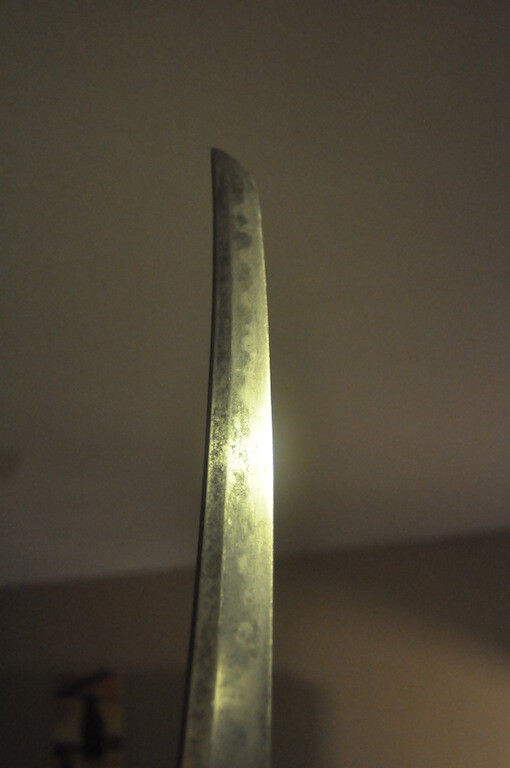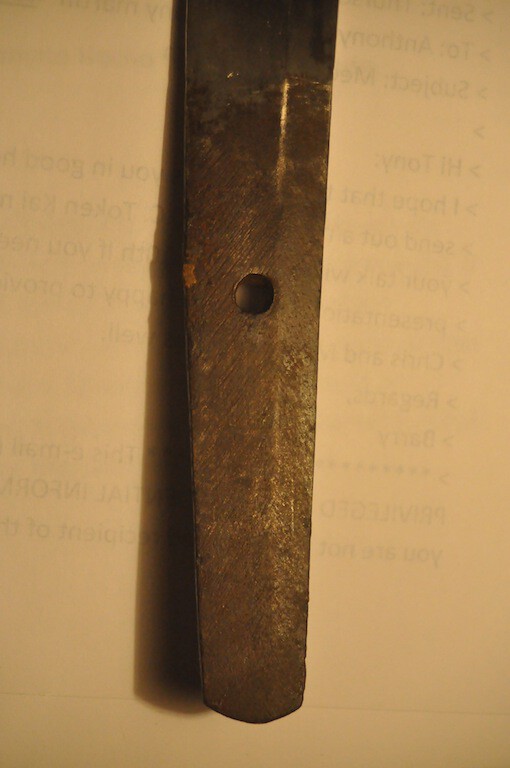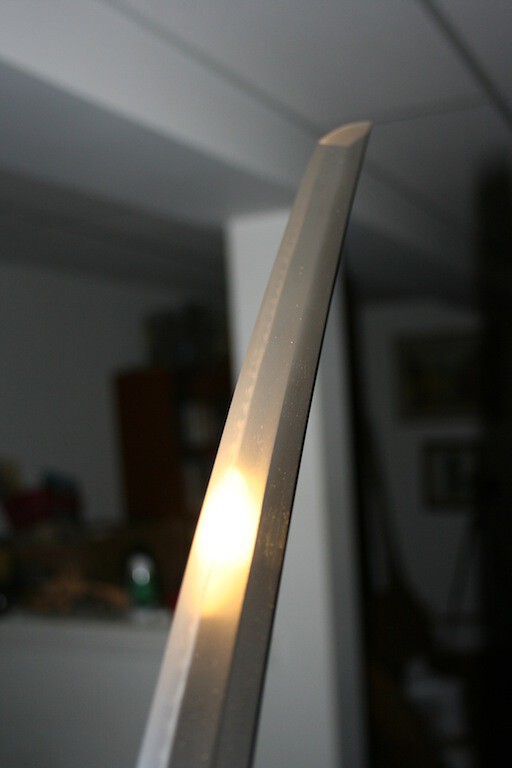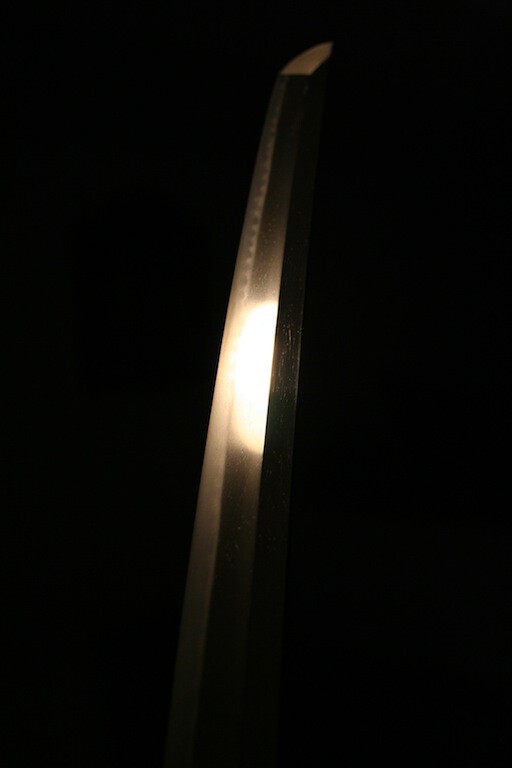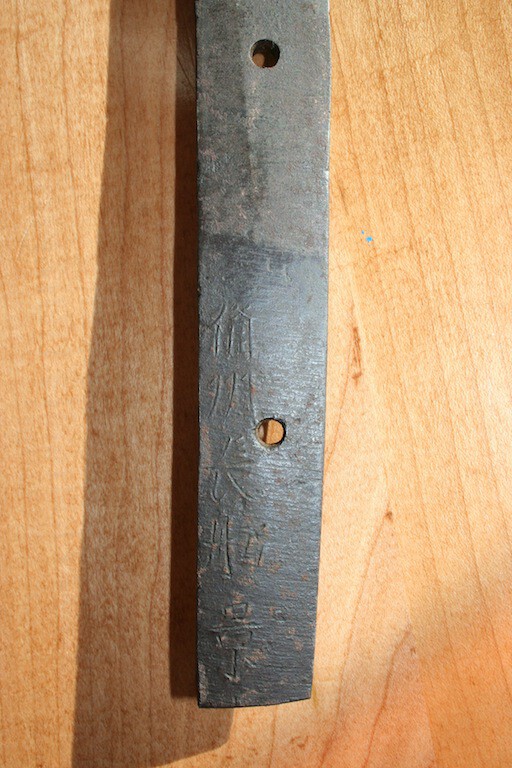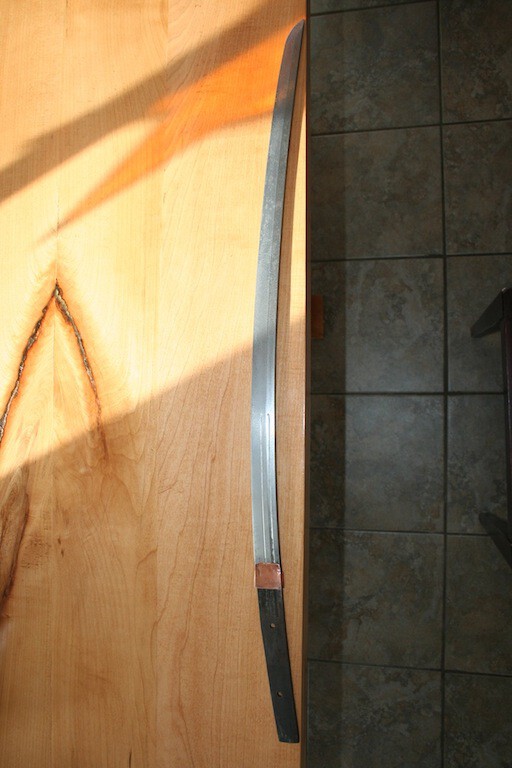
templar44
Members-
Posts
65 -
Joined
-
Last visited
Content Type
Profiles
Forums
Events
Store
Downloads
Gallery
Everything posted by templar44
-
Excellant. Thanks guys and I take it Nobuiye is fashionable in the fittings world. :D Tony Martin What's the price of copper per pound right now?
-
George thanks for the quick reply. Anything helps. My resources for tosogu are limited so I will do what I can to research what you gave me. It is very appreciated. Tony Martin
-
-
This is a rather small mumei wakizashi. It appears to be mid Muromachi. I believe it is Mino. The temper appears to be gnome midare with some togare. In the right light some of the nioi kuchi can be seen and it appears to be wider than standard Mino. The file marks are takanoha. I was leaning towards a Naoe school with this blade. Any opinions would appreciated. Would like to see if I am off the mark. Sorry I can't give details of the hada as it is to obscured to see. The nagasa is 36.5 cm. The width at the hamachi is 2.7cm and the width at the yokote is approximately 1.8 cm. Look forward to any responses. Tony Martin
-
I have this tsuba that is part of the mounts for a Mino Kanetomo katana. I think it may have been cast. I think the signature is Nobuiye but I am unsure. I am not a fittings guy and have not really been bitten by the fittings bug yet. I am trying to remain focused on the blades for now. However I do admire them. I believe the tsuba is copper with some sort of chemical patina applied. My questions are: 1. Is this most likely a bad attempt to copy a good artisan or did he cast pieces as well. 2. I don't think the signature is good it looks cast as well. Am i wrong in this? 3. The sword was brought back from Japan by a british naval officer at the turn of the century. Would the tsuba's age reflect this time period. Thanks for any assistance, Tony Martin
-
-
Now for something completely different- Monty Python I believe I now have the image correct. Hope this helps. Tony Martin
-
-
I would appreciate any help deciphering this fuchi for me. I am not a fittings guy and do not know where to start with them as far as signatures go. In my limited knowledge I felt it may be a Mino goto style. Any help would be appreciated. Tony Martin
-
Just for fun. 1. Osafune Chikkakage 2. Bizen Sukemune 3. Seki Naotsuna 4. Yamato Shizu The first three I thought were reasonable for what I could see but the naginata was what I found difficult to place. I mean I am probably wrong on all counts but from just a picture they seem somewhat reasonable. Tony Martin :?
-
Deutch auction house way too low estimate
templar44 replied to Jorgensen's topic in Auctions and Online Sales or Sellers
For some reason I forgot to say I have not told my wife. Strange... Tony Martin -
Deutch auction house way too low estimate
templar44 replied to Jorgensen's topic in Auctions and Online Sales or Sellers
My son knows the value of my blades and how many I have. For some reason I have not had a chance to tell her yet! Do you guys have the same trouble communicating about these things with your spouses? Tony Martin -
A few years ago a medieval sword circa 1200 sold here in Toronto for $100,000. I held the sword and felt it was original. A dealer friend of mine who has examined far more than I felt it was fake. In the end who knows what runs through peoples minds. Additionally what is the back room information. For all we know that Sgt's uniform was from John Pantelone and he sent that stuff home before he was killed on Iwo Jima. Or the more likely is that two ego's were in the room with more money than knowledge. Tony Martin P.S Anyone want to buy a meatball flag for $5,000. It has a slight tear. :lol:
-
I have been slowly working on a book regarding Yamato school swords. As time progresses I will be able to devote more spare time and money to the project. I have already invested approximately $24,000 into blades from the 5 schools . I tell you this only to let you know that my intentions are serious. The reason I am doing it is to produce a book in English to aid in the study of this particular field of study. I picked this area of study because I figured it would be the easiest. Just kidding. We all know how hard it is to dig up precise information reading Yamato blades. Anyway, I happen to love Yamtato swords so the book is just an extension of that passion. The lack of material for non Japanese speaking enthusiasts on any thing related to nihonto is to say the least, frustrating! Therefore I will attempt to give a little back. What I am asking for from the membership is any help in locating the following items. 1. Thorough and detailed books on Sohei. I have those publications written by Stephen Turnbull already. Books in English if there are any would be terrific but I will attempt translating any in Japanese so long as it is worth the effort. 2. Books on the history of the original Yamato Shrines 3. Books specifically on Yamato swords in Japanese that may have gone that extra step to provide information. 4. Any thoughts on how to contact individuals running some of the major organizations in Japan i.e.;museums and perhaps shrines that would help to make them receptive to my endeavour. I do not want to travel to Japan and show up unannounced on their front door step. I can just imagine how flat my nose would be from all the doors slammed in my face. Of course they would all be slammed politely! I will leave it at that for now. Any assistance would be greatly appreciated and I look forward to any responses. Tony Martin
-
I started collecting nihonto when I was 25 years of age. I am currently 49. It fly's quickly! If you can bear it I will give some of my own thoughts on the topic and the reason why clubs and to a degree the shows are middle aged and up. A. TIME: The subject requires study. A lifetime is not enough. That is why I like it and have stuck with it. There is no quick fix with Japanese sword study. There is always something new around the corner. However those interested in the Readers Digest version soon become disinterested. The attention span must be there. Therefore younger students starting out in their lives may find it difficult to put the attention required into the subject at that busy time in their lives. B. MONEY: Without trying to flout the obvious this study requires money. Not just the swords are expensive. Look at the cost of books. Ask a 17 to 25 year old to spend a thousand dollars on Tanobe Sensei's book. Especially when they can't read it. That thousand dollars is a lot of gas and partial insurance cost. You can't drive a sword to your girlfriends place. (I have experienced this conundrum. It was most frustrating!) What is hardest to understand about all art is that it is not about the money. C. DECEIT: This goes hand in hand with money. As soon as anything has the potential for large value the vultures circle in and are prepared to rip the unknowing apart. The vultures develop their techniques over time to appear legitimate and get profit from your lack of knowledge. They pass themselves off as experts, teachers or reputable dealers. They will use phrases like "It's been in a fire." Or, " He's not a bad smith, but look at what I have here! By the way I have a client who wants a Gunto mounted sword. I could sell yours to him and maybe get your money back for you." I like this one that someone used on me when I was young and naive. "Wakizashi are not what collector's want. They are after katana's. I may be able to sell this but it will not get a great deal. They are worth about half as much compared to katana's. The red laquer on the tang is just old speculation about the smith probably. It means nothing." Deceit and half truths used on me when my knowledge was limited. Kiss that kanbun Osaka shinto wakizashi goodbye. I needed money for my young family and he was there to make sure I did not get what would really would have helped. When I realized what had taken place I was so disgusted I quit collecting for 5 years. These people are more harmful to the study of this art than all the other factors put together. I don't mind making a mistake. That is par for the course but to be swindled by supposed teachers etc. That is another issue. In conclusion to deceit, I believe that the older you get the wiser you become and you become less vulnerable to the vultures. Hence you will see more mature collectors in nihonto than say the collectors you might see at a Pokeman card show. D. PASSION: If there is no passion for the topic then interest will fail. Let's face it nihonto is a pretty obscure hobby in the grand scheme of things. If it was not for my passion for these art objects I would have quit studying and collecting after having been swindled. I am passionate about them and went back to them after 5 years with an even greater passion. It is this passion that allows us to overcome the adversity along the way and give us a true satisfaction in our chosen field of study. In retrospect, what I felt were passions that I had up to the age of 25 were fleeting. Now I would classify them as interests. It took the hardship and reward in the study of nihonto to truly define for me what passion for something was. What youth truly has that passion. Only time can tell. I look at my karate dojo as a comparison. There are always new faces but they come and go. Some of the younger faces get old but the older faces remain constant. They have a passion for it. E. KNOWLEDGE: Knowledge is power. Finding the right teachers and information sources are crucial. The Internet is unparalleled for the non Japanese student. When I first started to study nihonto you were so vulnerable to misinformation it was ridiculous. If you could not afford to go to the sword shows and network you were vulnerable. At the time, I could not. These were times where the treasure seekers could capitalize. There are so many Internet sites now that anyone having the least interest in the topic can do research enough in a year to set them on their feet and give them a working knowledge that makes them less vulnerable to the vultures. For the non-Japanese , books are more available now in English than they ever were before. I truly thank all those who put the effort in to accomplish this. Some may criticize them for mistakes and throw jeers from the hecklers box for unknown errors in their research but they are pioneers and true lovers of nihonto that despite criticism attempt to provide knowledge where traditionally there was none. Vultures hate them. In conclusion, it takes a combination of all of the above to understand and truly study nihonto. The above points prove that it is a lot to ask of a young person especially in a field of study that pertains to a supposedly by-gone era and one that is so vast. Movies and action novels help keep the aura of the swords alive but are of little value in educating youth about the true artistic merit of nihonto. These mediums generate interest but is that interest of true benefit? Perhaps. It may lead a small percentage of previously uninformed enthusiasts to start a lifetime of study but I believe the more information becomes readily available and the willingness of honest people to truly teach younger students will provide the stimulus for a greater proportion of younger students in the field of nihonto. Of course they too must have the passion for it or it is all for nought. You can take the horse to water.....! Just my thoughts and hope they will be of benefit, Tony Martin
-
Ego in check and stepping out on the limb: 1. Nambokucho (Tegai) 2. Circa 1400 3. Nambokucho 4. Kamakura
-
Will post more photos tomorrow. I am working now so it has to wait. I'll give you more details about it as well. Tony Martin
-
Matt I was browsing through some of the old topics as I am new to the forum. Enjoying some of the discussion. I came across yours and thought you may the photos I posted might give you a good idea of Shikkake gunome. I collect primarily Yamato. When I saw it come up for sale I grabbed it immediately. It is a tachi with a length of 76.4 cm. It was made in the late Kamakura to early Nambokucho period. The blade had Tokubetsu Hozon papers. I sent it to Tanobe Michihiro sensei to have the saya done. He states in his attribution that both the jigane and the hamon are both special features of Shikkake Norinaga. The blade is nice and typical Norinaga. I write this to give you an example of Norinaga hamon. I do not have a macro lens as of yet so it is difficult to show you the detail of the jigane. I will post it for you as soon as I do. Hope it is of value to you. Tony Martin
-
I am able to post more information now that I am at home. Geraint, the kasane is 1/4 inch. Jean, there are more photos to go with this post. I have placed the habaki at the point where the possible first hamachi is located. It is at the front edge of the habaki. (If you can call it a habaki. It is pretty banged up.) This photo also shows how the two hi finish. Hopefully it helps to clarify the image I was trying to convey. Thanks again, Tony Martin
-
Thanks Jean. Yes it was assumption based on the mei positioning and the fact that you can see where the position of what I deemed to be the first hamachi was placed. It is 2 inches further back from the current placement. What I thought may have been the original was positioned just to the end of the two grooves that have been cut in it. I know it is rather small for a Muromachi piece but I was not sure about the sizes of nodachi that Bizen smiths started to make. I was aware of the numerous smiths with a Kage to start their name it was just a hope on my part that perhaps a Bizen specialist might recognize a characteristic or two in the mei to point me in the right direction. I was by no means hoping for a perfect kantei from this. I don't get alot of opportunity to hash things out about my blades or others so I thought this might prove interesting to others as well as myself. Thanks again Tony Martin


